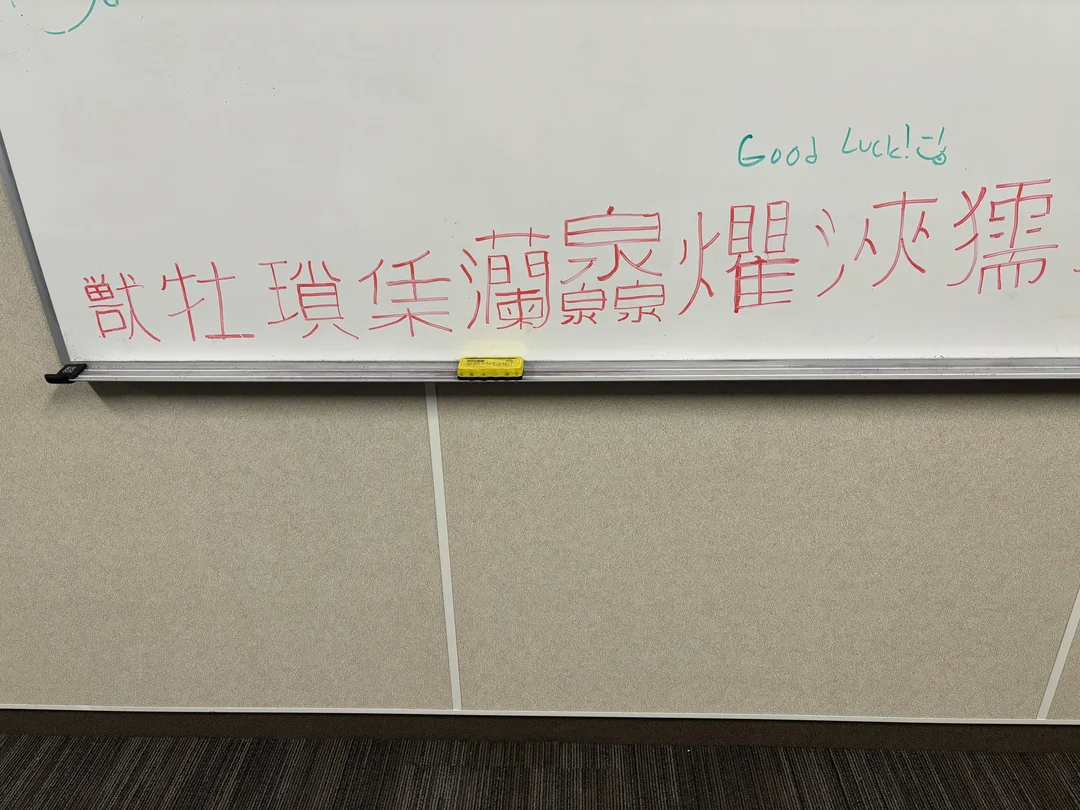Make a sentence look like it's chinese
I've seen a post on the transator subreddit of a white board with some chinese characters written in it. Those characters appeared to be random and, as it turns out, they were actually hiding a message in a very interesting way, so my immediate thought was: "Let's write some code".
The image that shows the chinese characters can be seen below
 A transcription for the characters is: "獣牡瑣栠灡灥爠浹獳"
A transcription for the characters is: "獣牡瑣栠灡灥爠浹獳"
In order to decode the message, one must take the characters on this board and convert it to its ASCII representation, which yields the following UTF-16 representation in hex, 0x7363 0x7261 0x7463 0x6820 0x7061 0x7065 0x7220 0x6D79 0x7373. Then, separate each octet in its own value, to get 0x73 0x63 0x72 0x61 0x74 0x63 0x68 0x20 0x70 0x61 0x70 0x65 0x72 0x20 0x6D 0x79 0x73 0x73, that if taken their representation in UTF-8, they reveal the message scratch paper myss.
First, make sure you have a Haskell compiler installed. In case you don't, one can be downloaded here: https://www.haskell.org/ghc/
Then, clone this repository
git clone https://github.com/pvpscript/chineseGo inside the cloned folder and compile it
cd chinese
ghc -o chinese main.hsThe program takes one of two parameters, --encode or -e, to encode a string into chinese characters and --decode or -d to revert the process.
$ ./chinese -d 獣牡瑣栠灡灥爠浹獳
scratch paper myss$ ./chinese -e hello world
桥汬漀
睯牬搀$ ./chinese -e seperate words "quite the big string"
獥灥牡瑥
睯牤猀
煵楴攠瑨攠扩朠獴物湧$ ./chinese -d $(./chinese -e go to chinese "and go back")
go
to
chinese
and go backThis document shows, in table 18-1, in what ASCII ranges the chinese characters are located.
Block Range Comment
CJK Unified Ideographs 4E00-9FFF Common
CJK Unified Ideographs Extension A 3400-4DBF Rare
CJK Unified Ideographs Extension B 20000-2A6DF Rare, historic
CJK Unified Ideographs Extension C 2A700–2B73F Rare, historic
CJK Unified Ideographs Extension D 2B740–2B81F Uncommon, some in current use
CJK Unified Ideographs Extension E 2B820–2CEAF Rare, historic
CJK Unified Ideographs Extension F 2CEB0–2EBEF Rare, historic
CJK Unified Ideographs Extension G 30000–3134F Rare, historic
CJK Unified Ideographs Extension H 31350–323AF Rare, historic
CJK Compatibility Ideographs F900-FAFF Duplicates, unifiable variants, corporate characters
CJK Compatibility Ideographs Supplement 2F800-2FA1F Unifiable variants
Using the extended ASCII range as a parameters, character values can go between 0 and 255, so, for this example, we will only take into consideration the ranges 0x3400 to 0x4DBF and 0x4E00 to 0x9FFF.
So, by looking at how this was implemented, it becomes clear that it may not always work, or at least it won't work for a few ASCII characters.
I simply wanted to replicate the idea presented by the deciphered code in the above image, so this little program simply transforms a list of characters into pairs of two octets, then converts them back into a character representation, which may or may not fall between the chinese character range, but overall it works okay.
The first element in a pair of the octets is created by shifting left the character value by 8 bits, which is the same than multiplying by 256. Therefore, in order for the algorithm to present a chinese character, the first element in the pair of octets must have a value greater or equal to 52, which translates to the character "4" (the number 4). However, in case the first octet is equal to 77 (the character "M"), then the second octet must be of a value of at most 191, which is the character "¿". Otherwise, it falls off of the leftmost value of the first range.
Still on the first octet, the maximum value must be of at most 159, that is translated to the character "ƒ" and falls in the extended ASCII part of the table. For the second value in the octet pair, it can be anything between 0 and 255, or 0x0 and 0xFF, unless the first value is 77, as discussed previously.
Knowing this, it becomes obvious that this is not a very good way to map characters of the latin alphabet into chinese characters, but that's just not the point of this, it never was.